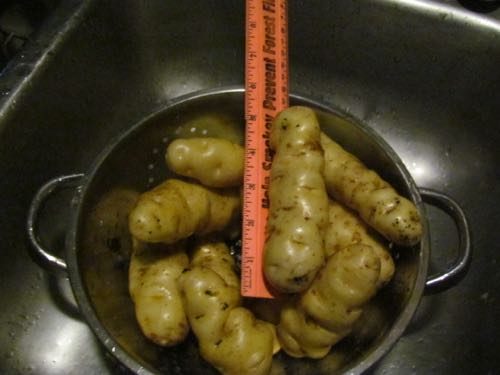Liberty Hyde Bailey once said, “A garden is half-made when it is well planned. The best gardener is the one who does the most gardening by the winter fire.”
For all you gardeners who are planning the coming growing season (see Does My Garden Need a Mission Statement?) we offer a bit of encouragement from our last season.
To wit: get a load o’ these ‘taters!
We started growing Native fingerling potatoes long before they became all the rage in exclusive urban restaurants. The two regional Native fingerlings are Kasaans (named for one of the Kaigani Haida villages in southern Southeast Alaska) and Maria’s, which are the variety grown by the Chilkat Tlingit of the Haines area.
John Muir described the latter as “walnut sized,” which is about what we expect each year. Both varieties are delicious—naturally buttery and slightly sweet. Last harvest season, we got far better results than that! Most of our fingerlings, both Kasaans and Maria’s, grew to about 3 times their normal size.
Michelle notes two differences in last season over others. One, we can’t do anything about, the other we can.
Last summer came warm and early. Everybody’s plants, particularly potatoes, did better than usual that year. It was an El Niño year, but we’ve harvested potatoes in many other such years without seeing such impressive growth.
Unlike previous years, Michelle hilled the potato beds with finished compost. She spread about 4″ over each bed in June.
As for the rest of it, Michelle took out our seed potatoes to warm in the 3rd week in March. She chitted them, which means laying them out in a single layer with eyes up so that they start to sprout. This makes shorter, more robust eyes rather than the long gangly ones that can form in the root cellar.
She planted the potatoes in early May as usual, with a small handful of spruce cone petals from local squirrel middens (to add acidity, which supposedly fights scab) and a handful of seaweed.
Now, in the winter, we’re enjoying larger fingerling potatoes. The main advantage I find is that the larger potatoes are much easier to clean and process than the small ones, which can be a bit fiddly to prepare for dinner. I’m for anything that simplifies meal prep!
We’re holding back some of the biggest for next season’s seed, of course. Hopefully, we’ll see more fat fingerlings in the future.

